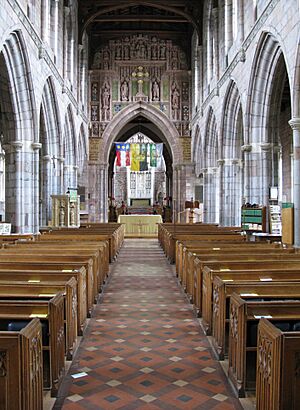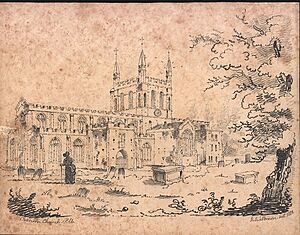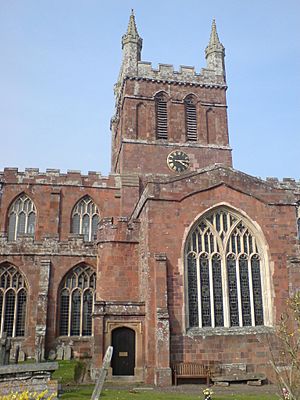Church of the Holy Cross, Crediton facts for kids
Quick facts for kids Church of the Holy Cross, Crediton |
|
|---|---|
| Collegiate Church of the Holy Cross and the Mother of Him Who Hung Thereon | |

Crediton Parish Church
|
|
| 50°47′22.70″N 3°39′8.21″W / 50.7896389°N 3.6522806°W | |
| Location | Crediton, |
| Country | England |
| Denomination | Church of England |
| Previous denomination | Roman Catholic |
| Churchmanship | Broad Church |
| Website | creditonparishchurch.org.uk |
| History | |
| Former name(s) | Minster Church of St Mary |
| Status | Parish church |
| Dedication | Holy Cross Blessed Virgin Mary |
| Architecture | |
| Functional status | Active |
| Architectural type | Basilica |
| Style | Perpendicular Gothic |
| Administration | |
| Parish | Crediton and Shobrooke with Sandford and Upton Hellions |
| Deanery | Cadbury Deanery |
| Archdeaconry | Exeter Archdeaconry |
| Diocese | Diocese of Exeter |
The Church of the Holy Cross, Crediton is a very old and important church in the town of Crediton in Devon, England. It is also known by its longer, more formal name: the Collegiate Church of the Holy Cross and the Mother of Him Who Hung Thereon.
This church stands on a special site. Long ago, around the year 1050, it was the main church, or "cathedral," for the Bishop of Crediton. A cathedral is where a bishop has their official seat. Later, the bishop's seat moved to Exeter, but a group of priests called "canons" stayed in Crediton. They continued to manage the church, which is why it was called a "collegiate" church.
The main parts of the building you see today, like the nave (where people sit) and the chancel (near the altar), were built in the 1400s. During a big change in England called the English Reformation in 1545, King Henry VIII took control of the church. The group of canons left, and the church buildings were then bought by the Crediton Town Corporation. This group still looks after the church building today.
Even though it's now a regular parish church, many people still call it the Collegiate Church of the Holy Cross. Its daily life and worship are planned by the clergy (priests) and a group called the parochial church council (PCC). The church is a Grade I listed building, which means it's a very important historical building in England.
Contents
A Look Back: The Church's Story
The Church of the Holy Cross in Crediton has a history that is just as long as Exeter Cathedral's. In the early 900s, Crediton was chosen to be the main church for Devon and Cornwall. A cathedral was built there around 910 AD by a person named Eadwulf of Crediton.
However, in 1046, a bishop named Leofric was put in charge of both areas. He decided to move the main church for Devon to Exeter in 1050. The bishop's special chair, called the cathedra, was moved to Exeter. It was placed in an old Saxon church until a new cathedral could be built, which took many years.
Crediton lost its status as a cathedral town, but the Bishop of Exeter still had a palace and lands nearby. The church itself continued, though not in its original building. A new Norman church started being built on the current spot around the 1130s. This became a "collegiate church," meaning it was run by a group of priests called canons and vicars. At first, there were 18 canons, but this number soon dropped to 12 because there wasn't enough money.
The collegiate church was always "secular," meaning the priests did not live like monks in a monastery. They were paid from the income of the church's lands.
The church was first dedicated to St Mary. But after the 1230s, it became known by its current name: the Church of the Holy Cross and the Mother of Him Who Hung Thereon. In the late 1200s, the church got bigger with the addition of the Lady Chapel and the Chapter House.
John de Grandisson, who was the Bishop of Exeter from 1327 to 1369, wanted the main leaders of the church, like the precentor and treasurer, to live close to the church. Bishop Grandisson also had a big impact by bringing back the special honor given to Saint Boniface. St Boniface was born in Crediton, and the bishop made sure this was well known. A new statue of St Boniface was made in the 1970s by a sculptor named Witold Gracjan Kawalec.
Around the early 1400s, the old Norman part of the church was falling apart. People left money in their wills to help rebuild it. This allowed for a complete rebuilding of the nave and chancel areas. Building large churches needed a lot of money. The new church was built in the Perpendicular Gothic style, which was popular at the time. It was impressive in size but had a simpler design.
Between 1545 and 1549, many collegiate churches were closed down. Crediton's church was given to King Henry VIII in May 1545. Soon after, the people of Crediton talked with the King's government to buy the church, which was in danger of being torn down. They finished the deal in the spring of 1547, paying £200 to the king. In April 1547, King Edward VI signed a document that created a new way to manage the church. This was a group of 12 governors who would look after the church buildings and its money. A vicar was appointed for Crediton, along with two chaplains.
Today, these twelve governors of the Crediton Church Corporation still own and manage the church buildings. Only two other parish churches in England, the church of Ottery St Mary in Devon and Wimborne Minster in Dorset, are managed in a similar way.
Fun Sayings About Crediton
There's an old saying: "That’s Exter (Exeter), as the old woman said when she saw Kerton (Crediton)." This saying means you thought you were done with a task, but you find there's still a lot more to do. The story goes that a woman was going to Exeter for the first time. When she saw the big, beautiful church in Crediton, she thought it was Exeter Cathedral. She said, "That's Exter, and my journey is over!" But she still had eight miles to walk!
Important Memorials
Inside the church, you can find several important memorials:
- A memorial with a statue of William Peryam (1534–1604). He was an important judge called the Lord Chief Baron of the Exchequer. This is on the north side of the chancel.
- The Tuckfield Monument is next to the Peryam monument. It has a seated statue of Elizabeth Tuckfield (1593–1630). Her family later lived in the same house as Peryam's family.
- A special window from around 1924 on the south wall. It was given by W.M. Smith-Dorrien, who was the Vicar of Crediton. It shows the coats of arms of many old families connected to the church.
- Statues of John de Sully (1282–1388) and his wife Isobel. John de Sully was a lord of the manor of Iddesleigh. These are at the east end of the south choir aisle.
- A memorial to Redvers Buller (1839–1908). He was an army general who received the Victoria Cross, a very brave award. He lived at Downes House in Crediton. This memorial is on the west side of the tower arch.
The Church Organ
The church has a special organ called the War Memorial Organ. It was designed based on plans made by the church's organist, Harold Organ, in 1915. Sadly, Harold Organ was killed in action in 1917. But his plans were continued by Cyril Church. The organ was built by Harrison and Harrison of Durham and was first used in 1921. The organ was repaired and given a new case in 2001.
Past Organists
- William Hayes (1838 - 1850)
- Frederick Dean (1851 - 1854)
- John W. Bradley (1855 - 1869)
- E.H. Birch (1869 - 1870)
- William J. Kempton (1870 - 1871)
- H.J. Stone (1871 - 1879)
- Arthur Jackman (1879 - 1882)
- Charles Walter Clarke (1882 - 1911)
- Norman Frederick Byng Johnson (1912 - 1914)
- Harold C. Organ (1915 - 1917)
- Cyril G. Church (1917 - 1945)
- Marjorie Jaco (1945 - 1960)
Church Services
Here are the regular services held at the church:
Sunday Services
- 8:00 am: Holy Communion (a quiet service)
- 9:30 am: Parish Eucharist (the main Sunday service)
- On the 1st Sunday: Family Communion in the Boniface Centre.
- 6:00 pm: Evening Services
- 1st Sunday: Choral Evensong (with a choir)
- 2nd Sunday: Sung Evensong at St Lawrence's Chapel
- 3rd Sunday: Sacred Space (a quiet, reflective service at Holy Cross)
- 4th Sunday: Sung Compline at Holy Cross (a peaceful evening service)
- 5th Sunday: Taize Vespers at St Lawrence's Chapel (a service with simple, repeated songs)
Weekday Services
- Tuesday
- 8:15 am: Holy Communion
- 4:45 pm: Evening Prayer
- Wednesday
- 9:15 am: Morning Prayer
- 12 noon: Holy Communion at St Lawrence's Chapel
- 4:45 pm: Evening Prayer
- Thursday
- 8:15 am: Holy Communion
- 4:45 pm: Evening Prayer
- Friday
- 8:15 am: Morning Prayer
- 10:00 am: Holy Communion (a quiet service)
- 4:45 pm: Evening Prayer
Other Churches Nearby
The Church of the Holy Cross is part of a group of churches called the United Benefice. Here are some other churches and chapels in this group:





